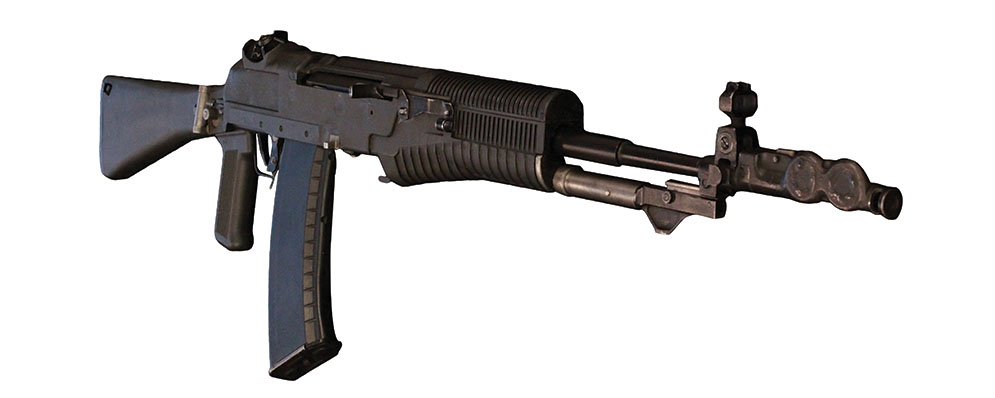By David Lake
The war machine of the Soviet Union has always been a source of intrigue to those interested in the development and proliferation of arms. The cold war era is full of truly incredible if not seemingly impossible military developments by the Soviets; the submarines, rockets, armored vehicles, aircraft, nuclear powered, and small arms from the period could easily be mistaken for today’s science fiction. Their secret military programs are indeed often the subject of Hollywood films; but sometimes reality is stranger than fiction. This is the AN-94; the Avtomat Nikonova-94. To keep it short, the Nikonov, or Abakan. Most gun enthusiasts have never heard of it. Few have ever seen it. And you could count on one hand the number of Americans who have fired it. This rifle is a paradigm of military small arms innovation in the last 50 years.
Through the 60s and 70s, most of the world’s major powers had adopted small caliber, high velocity cartridges to replace the .30 calibers of the past decades. In 1974, the 7.62mm AK-47 was replaced by the AK-74, essentially the same rifle, but now chambered in a new 5.45mm cartridge. The 5.45 offered lighter recoil, better control and accuracy in automatic fire, and a soldier could carry more ammunition on his person. But in action, the AK-74 was not on par with other modern rifles on the battlefield. Control and inherent accuracy in automatic fire were found to be unacceptable, despite the promises of the new cartridge. By 1981, the Soviet Union was looking to advance its small arms program yet again. The USSR Council of Ministers issued the call for new trials to begin; to create a better battle rifle. This endeavor became known as Project Abakan, or the Abakan Trials. The requirements set forth for the new rifle were very ambitious. The new rifle would be expected to improve on all aspects of the AK-74; accuracy (in full-auto and slow aimed fire), fire rate, weight, reliability, and mission capability and adaptability. For almost 15 years, twelve teams of Russia’s top engineers and weapons designers worked toward this goal. One of these engineers, Gennady Nikonov, created and built over 20 prototype rifles to prove principles of operation and demonstrate mechanical function. The exact details of Project Abakan may never be known publicly, so all we can conclude with any certainty is the outcome. By 1994, One of the rifles created by Nikonov had won the Abakan trials. But the cold war was already over. Russia’s engagement in Afghanistan was already over. The arrival of this game-changing rifle from the future was over 4 years overdue. The AN-94 would not be adopted as a general replacement for the AK-74, however it was put into production and reserved as a special purpose weapon for the Spetznaz.
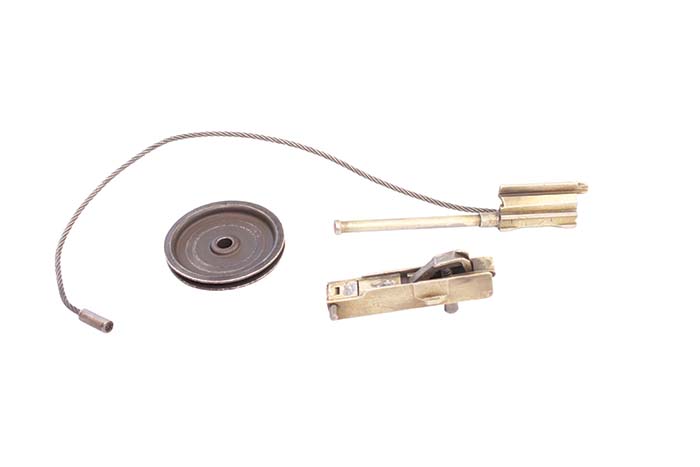
To see the Nikonov in person is an experience in itself. The gun is so far-out and unexpected you find yourself searching for an answer or explanation. You can guess from the visual clues that it’s Russian. The gun is totally utilitarian; its external shape is simply what happened when they covered up the machine that hides within. The AN-94 has no aesthetically pleasing lines – it’s disproportionate and bulky. Any exposed steel surfaces are simply painted black. All surfaces inside and out are crude. There is no polishing and there are no high-performance surface coatings. The weapon is roughly machined steel and plastic casting. The majority of the exterior is heavy polymer molded around a steel skeleton. There are areas inside and out where the skeleton protrudes from the polymer to serve as guide rails and other working surfaces. The construction is similar to the ubiquitous polymer-framed pistol of today. The receiver and forearm are molded as a single unit for simplicity and strength. The Nikonov’s shape does however resemble an AK. The molded top cover is shaped like the AK’s stamped sheet metal top cover. The magazine latch is nearly identical to the AK. The grip’s shape is similar to the AK, but is nearly vertical as the trigger pulls slightly downward rather than swinging up and rearward. The charge handle’s location is where you’d find that of the AK. The side folding stock is basic; made of hollow plastic with a compartment for a cleaning kit. The stock is notably longer than a typical AK stock, so the rifle is a better fit for a larger shooter. The stock folds and locks to the right side of the gun so it does not interfere with the optics mount, but does interfere with operation of the bolt and trigger. The Nikonov will use any magazine intended for the AK-74. One point of interest is the orientation of the magazine; it’s positioned approximately 10 degrees away from vertical, hanging off to the right side of the rifle. The magazine’s unusual position is required to allow for the unique internal workings. The front sight is a post protected by a “TV view” window with night sight ears protruding from the top of the protective hoop. The rear sight is a 5 position rotary aperture, calibrated for 2, 4, 5, 6, and 7 hundred meters. The sight is mounted at the 2 o’clock position atop the rifle towards the rear of the receiver just above the trigger, allowing quick range adjustments with the thumb or index finger of the trigger hand. The rifle is equipped with the standard soviet side plate optics mount; which is an integral part of the internal steel skeleton. This quick detach mounting system has been featured on almost every battle rifle built by the Russians since the mid-1950s, so the Nikonov offers reverse-compatibility with most Russian optics. The muzzle is fitted with a strange looking brake. It has only 3 ports; a single small port at the 1 o’clock position of the first chamber and two small cuts just at the muzzle. The gas system that is visible atop the AK’s barrel is missing; though the Nikonov does indeed function with a long stroke piston. The piston structure is shorter and thinner than that of the AK and is concealed within the forearm. There is another tubular structure hanging below the barrel. This tube conceals the recoil spring for the reciprocating receiver. This structure serves as a mounting point for a grenade launcher, and bears the guide rail upon which the reciprocating barrel assembly rides. The crossbolt style safety is just ahead of the trigger guard, and is easy to access with the trigger finger. The safety effectively locks the carrier forward. The Nikonov offers no mechanical means of locking the bolt to the rear. While the rifle is set to “safe,” the bolt cannot be moved. The selector operates in a track and moves fore and aft. It is on the left side of the grip, within easy reach of the thumb. Internally, the only feature shared by the AK and the AN-94 is the shape of the bolt and how it interfaces with the carrier. However, the Nikonov’s bolt and carrier are much smaller – maybe half the scale of the AK’s comparable parts.
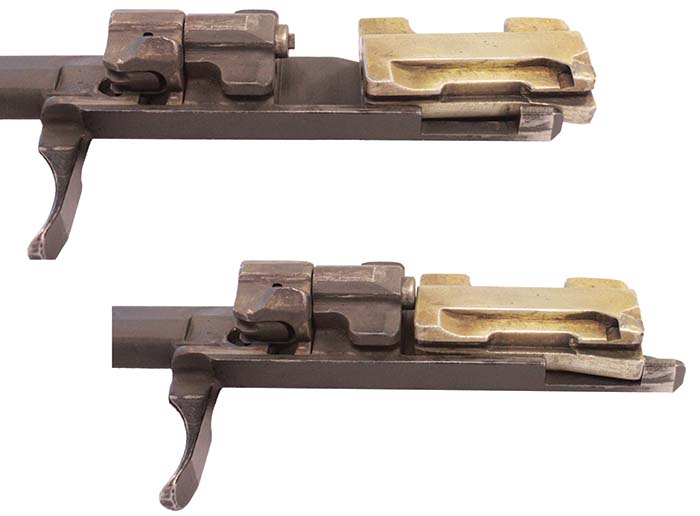
The Nikonov offers three modes of fire; semiautomatic, two-shot burst, and fully automatic. The burst mode is what really sets this rifle apart. In burst mode, it can send out a pair of projectiles at an effective 1,800 rounds per minute. That’s 33 thousandths of a second apart (.033 second); two and one half times the rate of the M4. Among all modern military arms, the Nikonov owns the honor of the highest rate of fire for any shoulder fired small arm in service. In actual fact it currently owns the highest fire rate for any single barrel. Heckler and Koch experimented for 20 years to create a rifle that could have exceeded the fire rate of the AN-94. But this project, known as the G11, never made its way to field service. The other close contender to the title was another rifle designed by Gennady Nikonov. This was a twin barrel shoulder fired 5.45×39 light machine gun that would have delivered a completely mad 3,000 rounds per minute in sustained fire.
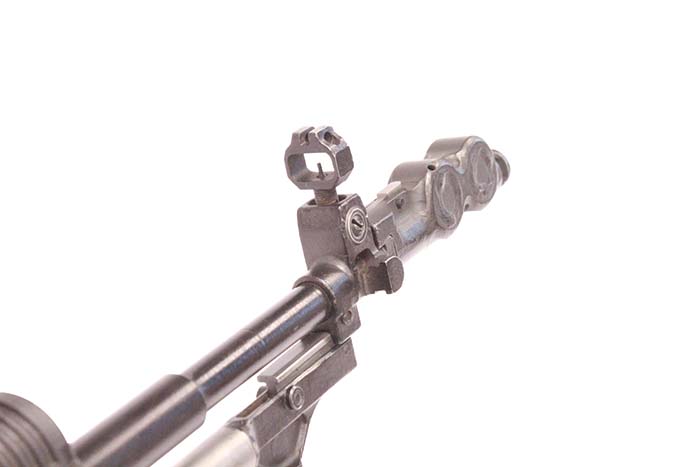
The AN-94 consists of a barreled receiver that reciprocates within an outer shell, or how it’s translated from Russian, and referred to herein as, “the envelope.” The receiver assembly carries the barrel, bolt, carrier and piston, sliding hammer, and a cartridge shuttle. The envelope is composed of the stock, grip, trigger mechanism, magazine well, and a cartridge carrier. The bolt and carrier and hammer travel within the receiver, and the receiver assembly and barrel, travel within the envelope. Due to the major differences in recoiling mass, the receiver and bolt assembly travel at very different rates during fire. The masses of the major moving parts are carefully balanced to manipulate cycle times for the receiver and bolt carrier. This balance of mass and force plays a key role in achieving the high rate of fire. This reciprocating function also serves to dissipate felt recoil. The interface between the receiver and envelope is not unlike the soft mount used for modern heavy automatic weapons. The result is that very little recoil energy is transferred to the shooter. Under the effect of recoil, the receiver can move almost one and one half inch rearward within the envelope. The method of function is referred to as “blowback shifted pulse.” The locking bolt is gas operated, yes, but the receiver is set in motion by recoil, or blowback. And the “pulse” refers to the impulse or energy created by a fired round. The reciprocating mechanism delays or “shifts” the energy pulse to a later moment in time.
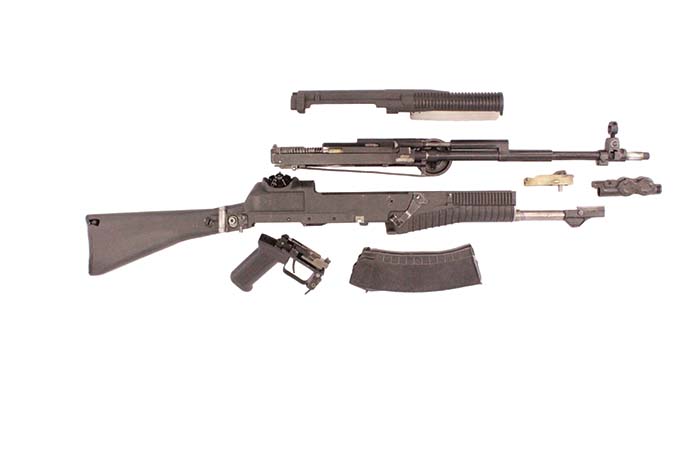
In semiautomatic fire, the Nikonov operates similarly to any other semi-auto rifle. At each shot, gasses diverted from the barrel act against a piston connected to the bolt carrier. The carrier then forces the bolt to unlock from the breach. The sliding hammer is forced rearward by the bolt until it is engaged by the sear. This is where the Nikonov begins to differ from other guns. Normally, a trigger will disconnect from the sear by way of mechanical input from the bolt or carrier. In the Nikonov, the trigger disconnect is actuated by the recoiling receiver itself. The bolt can then return to battery as the receiver returns to its forward location. The sliding hammer is maintained at the rear of the receiver in a cocked state; ready for the next trigger pull.
Before we get further into the cyclic function, it should be understood how the Nikonov gets ammunition from the magazine into the chamber. The Nikonov incorporates a “pre-feed” system, whereby rounds are stripped forward from the magazine by a shuttle that delivers them into a carrier that serves to raise the cartridge up and into the path of the bolt as it closes. The shuttle is connected to the bolt carrier by means of a steel cable routed around a pulley. By this arrangement, as the bolt travels rearward to eject a spent case, the shuttle travels forward to strip a round from the magazine. The Nikonov is a multi-tasker – it ejects a spent case and feeds a new cartridge simultaneously. The carrier that elevates the cartridge also facilitates reliable feeding from any location as the receiver moves within the envelope. In semi and full auto modes of fire, the bolt must close on the chamber while the receiver is nearing its forward battery position. In burst fire mode, the bolt is required to close while the receiver is traveling rearward and then again while the receiver is at its rearmost position. So the bolt must be able to feed a fresh cartridge from any position within the receiver’s range of motion. The recoil spring resides under the receiver and acts against the feed shuttle forcing it rearward. The feed shuttle and bolt carrier are connected by the cable. As the shuttle travels to the rear under the influence of the recoil spring, the bolt is pulled forward into battery. The ventral location of the recoil spring is the reason for the magazine’s odd orientation.
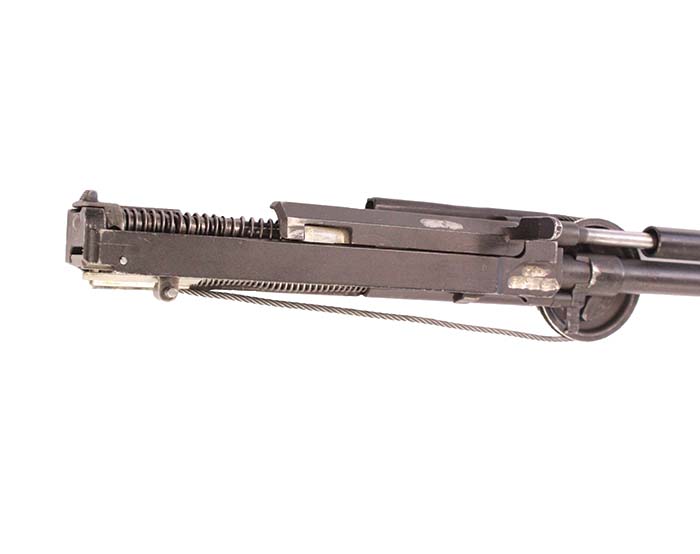
The workings of the Nikonov are extremely nuanced. Many have attempted to realize and rationalize its internal operation; and have given up, failed, or just guessed. This weapon can fire, eject, reload, fire, eject and reload, with perfect reliability, while almost totally eliminating recoil, in less time than the human eye can blink. Quite literally, the Nikonov fires two rounds just 33 milliseconds apart. Your eye blinks in 150 milliseconds. So you can imagine that an attempt to break down this mechanical function; so compressed in time can be a tedious task. So bear with us, we shall now expound on the internal function step by step, starting from a closed, loaded chamber, with the selector set to burst mode.
The trigger is pulled, and through a series of linkages (which will be explained later), lets the sliding hammer loose. The sliding hammer travels down its guide rails in the receiver to strike the firing pin, at the rear of the locked bolt. The sliding hammer is allowed to shift sideways in its rails, and lock into place, becoming a fixed part of the carrier assembly. The cartridge is ignited, projectile begins moving, and rearward recoil begins acting on the entire locked receiver. This recoil energy overcomes the receiver’s inertia, and the receiver begins to travel rearward, at a comparatively slow rate. As the bullet passes the gas port, energy acts on the piston, just above the barrel. The relatively lightweight piston and carrier assembly is forced rearward, unlocking the bolt from the breech. As the bolt travels to the rear, it acts on the cable and pulley, which activate the cartridge shuttle. The shuttle travels forward to strip a fresh cartridge from the magazine and presents that new cartridge into the cartridge carrier, just ahead of and above the magazine. The spent case has ejected; the bolt and carrier begin their return to battery; the barrel and receiver are still traveling rearward. As the bolt travels forward to meet the barrel, and the barrel travels aft to meet the bolt, the cartridge carrier raises and presents the round between the barrel and bolt. When the bolt and barrel meet and lock with a fresh cartridge chambered, the hammer, still fixed to the carrier, ignites the cartridge immediately upon locking. A second recoil impulse transfers more recoil energy to the reciprocating receiver. The receiver finally reaches its rearmost position within the envelope. As the bolt completes the second ejection cycle, and reaches its rearmost position within the receiver, it delivers a rearward blow to the receiver, delaying its return forward, but allowing enough time for the cartridge carrier to present another fresh round. The bolt, carrier and barrel can now return to forward battery, with a live round chambered, ready for the next burst. And the shooter has only felt a single recoil impulse – seemingly the result of only the second shot fired. The end result on target is two very closely placed shots. In the full automatic setting, the first two rounds always fire at the burst rate of 1,800 rpm, and continued fire resumes at the normal rate of 600rpm. As the user fires in full-automatic, the sliding hammer does not travel with the carrier; it is only released at the moment that the bolt and receiver return to forward battery. Semi-and full-auto modes of fire utilize the reciprocating sub-receiver to attenuate recoil and improve accuracy and time of follow-up shots. The burst function makes use of the extended time interval during the receiver’s rearward travel.
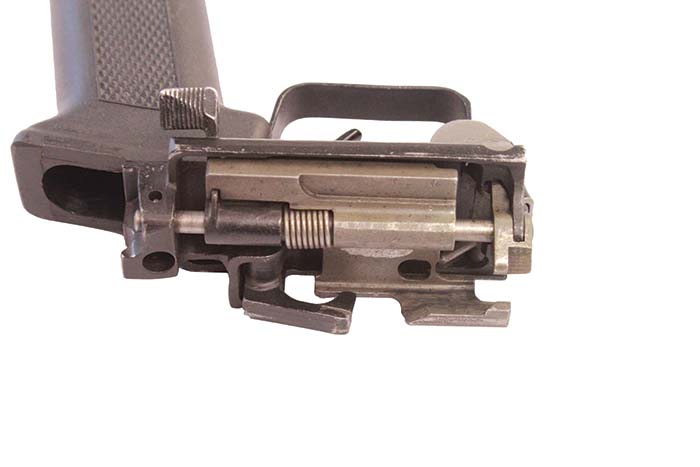
Perhaps the most overlooked achievement of the Nikonov is the fire control, or trigger pack. It does not function like any other trigger mechanism on the planet. The trigger pack only houses the trigger, selector and safety. The selector switch slides in a track just above the pistol grip. The complexity and genius of the selector lies in its gross simplicity. As the selector moves fore and aft, a series of ramped edges along a hook are relocated in any of three positions beneath the receiver. The trigger simply pulls down on the selector hook. The sear itself hangs from beneath the receiver. The sear contains a horizontally oriented plunger that serves as the disconnector. The selector hook pulls down on the disconnector to release the hammer and fire the gun. The sear disconnects from the selector hooks when the receiver travels far enough rearward to clear the hooks completely. The sear is operated to fire the gun in two ways; when the disconnector travels into one of the ramped surfaces on the selector hook or when the selector hook receives direct input from the trigger, to pull down on the sear. The different fire rates are controlled by where the disconnector is activated in the receiver’s field of motion. In semi-auto, the selector shelf is farthest forward, resulting in disconnect immediately following ignition. The hammer is captured by the sear each time the bolt carrier makes cycles. In full auto, the selector hook is at its rearmost location. The disconnector is allowed to escape from under the selector hook so that the sear may capture the hammer. As the receiver returns to forward battery, the disconnector encounters a ramped surface that pulls down on the sear, releasing the hammer just as the bolt carrier closes on the breech. In burst mode, the first shot functions like a closed bolt striker fired system except the sear does not disconnect following the first shot. The sliding hammer is not caught by the sear but instead remains locked into the bolt carrier. The bolt and hammer are allowed to return to battery as the receiver is still traveling rearward. This results in a second shot being ignited immediately as the breech closes; as if it were an open bolt firing mechanism. The recoil stroke from the second shot forces the receiver into a position relative to the selector hook where the disconnector can now escape, and the sear can capture the hammer as the bolt and receiver both return to forward battery, ready for the next shot.
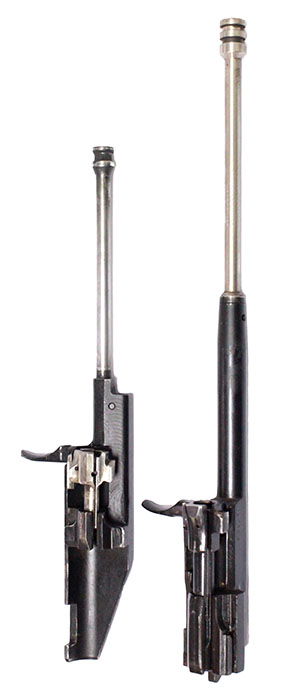
The AK-47 bolt and carrier (right) in comparison to the AN-94’s bolt and carrier (left). It is assumed that size and weight of these components was kept to a minimum in order to facilitate the extreme cyclic rate.
Here is a simplified review of the operation. In burst mode, the sliding hammer locks itself to the bolt carrier after the first shot. The sear will not disconnect until after the second shot, thus will not capture the hammer yet. The second shot is fired from an “open bolt” condition as the sliding hammer is locked against the carrier and firing pin. This way, all which is required to fire the second shot is that the bolt close on a live cartridge. And to expedite things, the barrel is moving rearward to meet the bolt half way. Nearby, the feed shuttle strips a round from the magazine and pushes it into the cartridge carrier which lifts it into the bolt’s path just before the bolt and barrel come together around the cartridge. In normal full-auto fire, after the second shot, the mechanism operates step-by-step; not dissimilar to any conventional automatic rifle. The bolt returns to battery, closing on a fresh cartridge, as the receiver reaches forward battery. As the receiver comes to rest, the selector hook activates the sear to release the sliding hammer to begin its trip forward to contact the firing pin to ignite the chambered round. The difference in fire rate between full-auto and burst fire is attributable to mechanical lock time; the time it takes for the receiver, bolt, and hammer to travel back and forth, and where the sear is allowed to disconnect. The muzzle brake is worth mentioning again. Muzzle brakes are designed to mitigate recoil, but for a gun that uses recoil in its proper function, this would be counterproductive. We were interested to discover that the gun would not function at the burst fire rate without the brake affixed. The gun only fired at 600 rpm, in burst and auto setting. The hypothesis we came up with suggests that the closed internal volume of the brake does not dissipate or redirect recoil but instead captures the expanding gasses that cause recoil and retains these gasses as potential energy. The compressed gas is allowed to escape the brake’s chambers over time, in a controlled “flow” to extend the duration of recoil effect.
The AN-94 boasts an incredible fire rate to be sure, but some promoters make impossible claims to the gun’s effect. It has been said that a burst from the Nikonov can place both rounds in a single hole at 100 meters. It has been said that the burst effect can defeat armor. These are simply not true. The rounds fired in burst do impact close together, but do not coincide, as our test targets demonstrate. It would be safe to assume that the intention of Gennady Nikonov in building this burst feature was not to put two rounds into the same hole. More practically, his intention was to increase a shooter’s chance of making a hit on target, and increase the lethality of those hits. Fire rate has never been a guarantee of a rifle’s effect. The success or failure of any weapon system is due entirely to the training and expertise of its operator. This is no secret to the world’s armed forces. Every country has its elite or special forces; these special units often use the same standard issue small arms as the regular soldiers. These special units can put those arms to greater effect only by inherent skill and exhaustive practice. With that in mind, and considering the expense, complexity, and capability of the AN-94, Russia has reserved this weapon for its special operations unit; the Spetsnaz. Is the AN-94 really “better” than the AK-74 or AK-12 or any of the AK-100 series of variants. It would only be fair to call the Nikonov “alternatively capable.”
To say that the AN-94 is scarce in the western hemisphere is a gross understatement. Make no mistake; there are not many of these floating around outside the Soviet Union. So we did not hesitate at the chance to field test one of the world’s most rare and advanced battle rifles. The Nikonov would be tested in the Nevada desert, 30 minutes from Hoover Dam. First, just to get a feel for the “Nik,” we fired it off hand short range, in semi, full and burst. The reciprocating mechanism is very effective at dissipating recoil force. In semi-auto, the recoil felt was on par with a tuned match rifle. In burst mode, we noticed an increased recoil impulse compared to semi-auto, as the single perceived push is the result of 2 rounds fired. In full-auto, the gun is very controllable. The burst mode gets the hype, but full auto fire with the Nikonov is remarkable. We shot targets at 50 yards in burst and full. The burst rounds did not impact together. The best results we could manage showed groups averaging 2 inches spread vertically. In full auto fire, it was easy to maintain 8” groups from strings of 10 rounds. This shows that the rifle can maintain impressive control during automatic fire – better than any other battle rifle we’ve tested.
Is the Nikonov an innovative weapon. No. it’s beyond that. Most anything mechanical is formed after a preexisting idea, or can trace its development to another device. The AN-94 comes from… nowhere. It’s as great a quantum leap in small arms design as any of the original Browning guns. What spark of inspiration could have sent Gennady Nikonov to his desk to invent this rifle from thin air. Some have suggested a possible connection to some UFO activity in 1989 in Voronezh, Russia. Could the Nikonov be a piece of reverse engineered alien technology. We would love to think so; because there’s just no other logical explanation for this “Blackest” of black rifles.
| This article first appeared in Small Arms Review V19N2 (March 2015) |



